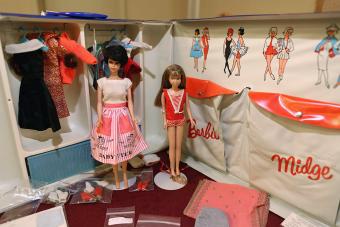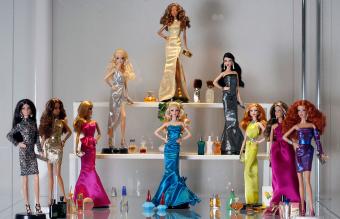
For many, it feels like Barbie dolls have been around for ages and maybe just long enough to be considered antiques. However, antique Barbie dolls won't enter the market for another few decades. In fact, these truly iconic American dolls may have taken the world by storm, but they've undergone all of these massive changes in line-up and style in only a couple of decades, many of which you probably lived through yourself.
Why There Are No Antique Barbie Dolls
By a strictly classic definition, a doll must be at least 100 years old to earn the honor of being an antique. However, most doll collectors, doll dealers, and doll specialists consider any doll made before 1930 an antique. The main reason for this seemingly arbitrary cutoff date has to do with the porcelain factories in Germany that produced doll heads. These factories used the same molds to make porcelain doll heads from the 1880s throughout the 1920s, making it difficult to determine the exact age of some dolls of this period. It's interesting to note that at doll shows run by the National Antique Doll Dealers Association, vendors can exhibit dolls made prior to 1949, further complicating what is and isn't considered an antique doll.
While they aren't antiques, a Barbie collector price guide shows these dolls can be quite valuable. Along with the typical rulings on antiques being at least a hundred years older than the current date, this doll-based definition means that all past and present Barbie dolls are considered vintage at best and modern at worst. Thus, if you're thinking about beginning a Barbie doll collection and don't want to look like a complete novice when you make your first few bids, make sure you don't refer to Barbies as antiques just yet.
The Barbie Doll Eras
Regardless of which definition of antique doll you use, Barbie still has many years ahead of her before she achieves the coveted title of being an antique doll. Doll collectors generally divide Barbie dolls into eras based on their production years:
- Vintage Barbie dolls - 1959 to 1972
- Vintage Mod Barbie dolls - 1966 to 1972
- Modern Barbie dolls - 1972 to present
- Collectible Barbie dolls - 1986 to present (these dolls are made for adult doll collectors)
Mattel Brings Barbie to the Masses
Introduced at New York's American Toy Fair in 1959, the first Barbie doll quickly won the hearts of little girls everywhere. Selling more than 351,000 of the teenage fashion dolls in its first year of release, the Barbie doll has been a staple in the toy industry ever since.
The idea of a teenage fashion doll came to Ruth Handler, co-founder of Mattel Toys, as she watched her daughter playing with her two-dimensional paper fashion dolls. The child was imagining her paper dolls in the role of grown-ups, which sparked Handler's creative intuition. Handler then designed the first Barbie in the style of a German fashion doll, manufactured from 1952 to 1964, named Bild Lilli. She named the Barbie doll after her daughter, Barbara.
The First Barbie's Iconic Design
The first Barbie, known as Ponytail Barbie, wore a black and white striped one-piece strapless bathing suit complete with accessories that included:

- Open-toed black shoes
- Gold hoop earrings
- White sunglasses with blue lenses
Barbie's hair was either blonde or brunette, styled in a fashionable below-the-shoulder ponytail with curled ends and curly bangs. Her eyebrows matched her hair color, and she had stylish red lips and a blush on her cheeks. This is the first, and only, year that Barbie's eyes had no color.
Vintage Barbie Throughout the 1960s
Through the years, Barbie's clothes, accessories and hairstyles changed in order to keep up with what was currently trendy. Generally, the name of the doll reflected the hairstyle or another distinguishing feature that was popular at the time. For example, the 1961 Bubblecut Barbie featured a fashionable small bouffant hairdo and was available in shades of blonde, brunette, or titian. Several other examples of early styles of Barbie dolls include:

- Barbie Swirl Ponytail (1964) - This model featured a heavy side-swooped bang and a neck-length swirled ponytail.
- American Girl Barbie (1965) - This model featured a chin-length bob parted in the middle with bangs
- American Girl Side Part (1965-1966) - This model featured a left side part, slightly flipped up hair and a turquoise ribbon hair band
- Color Magic Barbie (1966) - This model featured long blonde or black hair that, when touched by water, changed into shades of red.
- Hair Flip Barbie (1968) - This model boasted a new hairstyle mimicking the iconic shoulder-length flip from the tv show That Girl.
Barbie's Family Expands
It wasn't long before Mattel expanded the Barbie doll line-up and introduced a gaggle of fashion doll friends for Barbie to play with. Just two years after Barbie's release, Ken was introduced as the first male teenage fashion doll, and he quickly took on the role of Barbie's boyfriend. Available as a blonde or brunette, Ken was fashionably attired for the beach, and his original outfit included:

- Solid red swim trunks or red trunks with white stripes on the sides
- Red cork sandals
- Wrist tag
- Red and white striped jacket (optional)
- Yellow towel (optional)
Over the years, Mattel introduced many fashion dolls into the Barbie doll family. Some of them were members of Barbie's family and others were close friends. The following are a few of the many fashion dolls created by Mattel for the Barbie line over the years:
- Skipper Roberts - Skipper was a smaller doll released in 1964, intended to be Barbie's little sister. Initially, Skipper came in three different hair colors, though within a few years, her iconic black and purple hairdo was solidified.
- Todd Roberts - Todd was a child's doll, said to be Barbie's younger brother, that was released in 1966 and discontinued in 1971. However, Todd did undergo a few re-releases over the years.
- Tutti (re-released as Stacie) Roberts - Originally coined Tutti and later named Stacie, the doll was Todd's twin sister and Barbie's younger sibling that was also released in 1966.
- Midge Hadley - Midge was released in 1963, alongside Skipper, and was marketed as Barbie's best friend. However, this doll is perhaps best known for the short-lived pregnancy iteration that was released, and quickly removed, in 1982.
- P.J. Silver - PJ was Barbie's blonde pigtailed friend who was released in 1969 with the packaging "Talking PJ." These early iterations used the Midge mold to create PJ, but her Mod styling helped her stand out.
- Allan Sherwood - Allan was first released in 1964 and was meant to be one of Ken's best friends who was also molded to fit Ken's wardrobe. However, within two years, the Allan doll was discontinued and later reintroduced in the 1990s.
- Christie - Mattel introduced Christie in 1968 as one of the world's first black dolls of its kind. A Mod through and through, she was released in reflection of the Civil Rights Movement and growing equal rights sentiments in the United States during the 1960s.
- Shani - Shani (and her two friends Asha and Nichelle) was a departure from the western-molded dolls that Mattel had been releasing up until the 1990s. These black dolls were designed to be a truer reflection of Afro features and culture, and they stood on their own, outside of the typical Barbie pack.
Barbie Fashions and Accessories
For Barbie, being a teenage fashion doll meant having lots of beautiful and trendy outfits. For decades Barbie clothes, accessories, wigs, and shoes have filled Barbie closets and wardrobes in little girls' bedrooms and playrooms everywhere. Of course, Barbie's friends and family also love to look fashionable and have stylish wardrobes of their own, meaning that Mattel was never hurting for new products to market to Barbie doll-loving fans.

Additionally, Barbie's play sets grew from cardboard interiors to full-on mansions equipped with swimming pools and elevators. These Barbie doll dream houses, convertibles, and airplanes were just a few of the delightful gadgets that helped kids bring their Barbie doll's world out of their imagination and into real life.
You're Never too Old to Own a Barbie Doll
Ever since their introduction in 1959, Barbie dolls have completely changed the fabric of girlhood around the world. From groundbreaking advancements surrounding race, employment, body size, and sexuality, the Barbie brand has come to mean more to people than just being a child's plaything. And although these vintage Barbie dolls were far from perfect, they certainly meant something to young kids everywhere once upon a time, too. Now if you happen to collect other dolls besides Barbie, learn more about true antique doll values.







